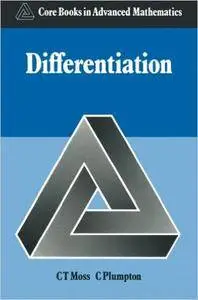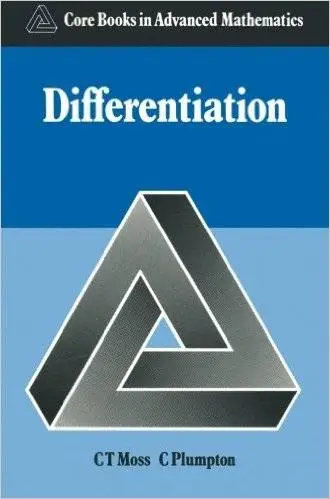C. T. Moss, Charles Plumpton, "Differentiation"
1983 | ISBN-10: 134906050X, 0333317947 | 68 pages | PDF | 4 MB
1983 | ISBN-10: 134906050X, 0333317947 | 68 pages | PDF | 4 MB
Preface
Advanced level mathematics syllabuses are once again undergoing changes of
content and approach, following the revolution in the early 1960s which led to
the unfortunate dichotomy between 'modern' and 'traditional' mathematics.
The current trend in syllabuses for Advanced level mathematics now being
developed and published by many GCE Boards is towards an integrated
approach, taking the best of the topics and approaches of the modern and
traditional, in an attempt to create a realistic examination target, through
syllabuses which are maximal for examining and minimal for teaching. In
addition, resulting from a number of initiatives, core syllabuses are being
developed for Advanced level mathematics syllabuses, consisting of techniques
of pure mathematics as taught in schools and colleges at this level.
The concept of a core can be used in several ways, one of which is mentioned
above, namely the idea of a core syllabus to which options such as theoretical
mechanics, further pure mathematics and statistics can be added. The books
in this series are core books involving a different use of the core idea. They are
books on a range of topics, each of which is central to the study of Advanced
level mathematics; they form small core studies of their own, of topics which
together cover the main areas of any single-subject mathematics syllabus at
Advanced level.
Particularly at times when economic conditions make the problems of
acquiring comprehensive textbooks giving complete syllabus coverage acute,
schools and colleges and individual students can collect as many of the core
books as they need, one or more, to supplement books already possessed, so
that the most recent syllabuses of, for example, the London, Cambridge, AEB
and 1MB GCE Boards, can be covered at minimum expense. Alternatively,
of course, the whole set of core books give complete syllabus coverage of single-
subject Advanced level mathematics syllabuses.
The aim of each book is to develop a major topic of the single-subject syl-
labuses, giving essential book work and worked examples and exercises arising
from the authors' vast experience of examining at this level and including
actual past GCE questions also. Thus, as well as using the core books in either
of the above ways, they would also be ideal for supplementing comprehensive
textbooks in the sense of providing more examples and exercises, so necessary
for preparation and revision for examinations on the Advanced level mathemat-
ics syllabuses offered by the GCE Boards.
In this book on differentiation, it has been assumed that the reader has a
rudimentary knowledge of calculus. Consequently, whilst the basic results and
general theorems on differentiation are given, no attempt has been made to
prove them. The writers' main concern has been to try to ensure that, given
basic results and general theorems, the readers can by (i) following the numerous
worked examples and (ii) working out for themselves the frequent complement-
ary exercises, be enabled to cope easily with all such examination questions to
be found in the GCE A-level papers. It is also believed that many first-year
university and polytechnic engineering and applied science students will find
the text a most helpful aid in ensuring proficiency in differentiation and its
applications. In an attempt to establish good techniques, the opportunity has
been taken of drawing the reader's attention to quicker and better solutions
whenever appropriate.
Approximately half of the book is devoted to the many applications of
differential calculus.
The authors are grateful to the following GCE Examining Boards for permis-
sion to reproduce questions from past Advanced Level GCE papers: University
of London Entrance and School Examinations Council (L); The Associated
Examining Board (AEB).
C. T. Moss
C. Plumpton
Advanced level mathematics syllabuses are once again undergoing changes of
content and approach, following the revolution in the early 1960s which led to
the unfortunate dichotomy between 'modern' and 'traditional' mathematics.
The current trend in syllabuses for Advanced level mathematics now being
developed and published by many GCE Boards is towards an integrated
approach, taking the best of the topics and approaches of the modern and
traditional, in an attempt to create a realistic examination target, through
syllabuses which are maximal for examining and minimal for teaching. In
addition, resulting from a number of initiatives, core syllabuses are being
developed for Advanced level mathematics syllabuses, consisting of techniques
of pure mathematics as taught in schools and colleges at this level.
The concept of a core can be used in several ways, one of which is mentioned
above, namely the idea of a core syllabus to which options such as theoretical
mechanics, further pure mathematics and statistics can be added. The books
in this series are core books involving a different use of the core idea. They are
books on a range of topics, each of which is central to the study of Advanced
level mathematics; they form small core studies of their own, of topics which
together cover the main areas of any single-subject mathematics syllabus at
Advanced level.
Particularly at times when economic conditions make the problems of
acquiring comprehensive textbooks giving complete syllabus coverage acute,
schools and colleges and individual students can collect as many of the core
books as they need, one or more, to supplement books already possessed, so
that the most recent syllabuses of, for example, the London, Cambridge, AEB
and 1MB GCE Boards, can be covered at minimum expense. Alternatively,
of course, the whole set of core books give complete syllabus coverage of single-
subject Advanced level mathematics syllabuses.
The aim of each book is to develop a major topic of the single-subject syl-
labuses, giving essential book work and worked examples and exercises arising
from the authors' vast experience of examining at this level and including
actual past GCE questions also. Thus, as well as using the core books in either
of the above ways, they would also be ideal for supplementing comprehensive
textbooks in the sense of providing more examples and exercises, so necessary
for preparation and revision for examinations on the Advanced level mathemat-
ics syllabuses offered by the GCE Boards.
In this book on differentiation, it has been assumed that the reader has a
rudimentary knowledge of calculus. Consequently, whilst the basic results and
general theorems on differentiation are given, no attempt has been made to
prove them. The writers' main concern has been to try to ensure that, given
basic results and general theorems, the readers can by (i) following the numerous
worked examples and (ii) working out for themselves the frequent complement-
ary exercises, be enabled to cope easily with all such examination questions to
be found in the GCE A-level papers. It is also believed that many first-year
university and polytechnic engineering and applied science students will find
the text a most helpful aid in ensuring proficiency in differentiation and its
applications. In an attempt to establish good techniques, the opportunity has
been taken of drawing the reader's attention to quicker and better solutions
whenever appropriate.
Approximately half of the book is devoted to the many applications of
differential calculus.
The authors are grateful to the following GCE Examining Boards for permis-
sion to reproduce questions from past Advanced Level GCE papers: University
of London Entrance and School Examinations Council (L); The Associated
Examining Board (AEB).
C. T. Moss
C. Plumpton



